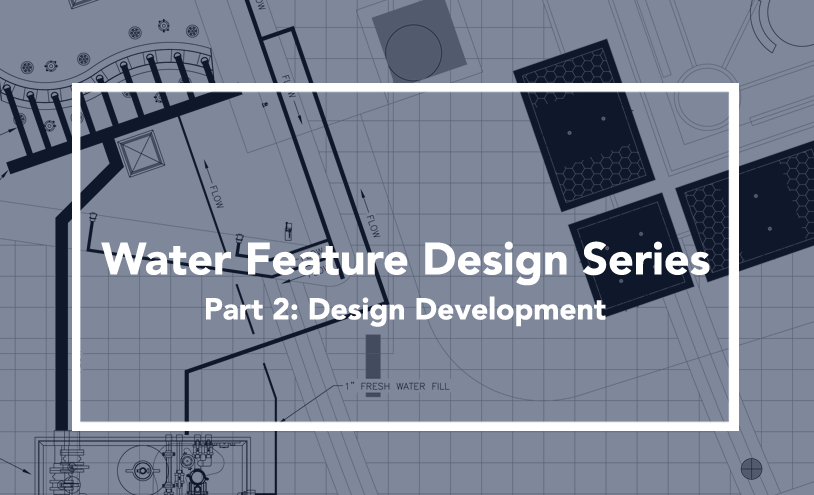This article is the second in a series covering the different stages of fountain design.


After the Concept/Schematic phase of the fountain design is approved, we of course, move into Design Development (DD). This is where we begin sizing and locating equipment, providing initial utility information to the MEP, and starting mechanical and electrical drawings.
Typically, even at the beginning of Design Development, there is enough information to get a close idea of the volumes and heads of pumps needed, as well as basic lighting requirements, pipe sizes and more. The client provides background drawings to the water feature consultant, so they can start laying out the plumbing and electrical drawings for review by the MEP, Architect and BIM consultants.
During this phase, items like pumps, filters and controls are physically sized and drawn to determine the necessary mechanical space needed. The resultant math on electrical current, drain sizes and water make-up utilities is given to the MEP. Custom equipment details, such as suction and discharge fittings, water make-up devices, nozzles and more, are also incorporated into the DD drawings.
An outline of the specifications is usually provided, in order to begin deciding exactly what products will be used for the system. While there are some products unique to our industry, most are not proprietary, which allows for competitive bids. It should be the goal of the specification writer to make sure that the products are specific for particular qualities, but not exclusively branded, unless absolutely necessary.
Even if a mock up was generated in the Concept/Schematic phase, it may be necessary to modify it further, regarding materials and textures, as the design becomes more developed. Sometimes, light and sound are additionally studied, due to concerns with particular proximities to people, plantings and more.
At this point, it should be determined whether the water feature is interactive. If the feature is deemed interactive, it’s imperative to have a copy of the Department of Health code for interactive fountains for the state in which it will be installed. If there is no state code, it is highly recommended that the state’s code for public swimming pools be complied with, regarding water quality. Public health and safety are most important with these features. Typically, adhering to these codes requires adding many components not used in non-interactive displays. These components and their installations need to be accounted for.
When the plans, details, utility basics and outline specifications have been ostensibly approved, it is time to again go through the process of estimating the cost of the system and its installation, before beginning the Construction Documentation process. Sometimes, between Schematic and DD phases, there are small disconnects, or simply new information that is discovered, that can escalate costs. The client needs to be aware of anything that affects costs, so he or she can make qualified decisions as to how the project will move forward into the Construction Documentation phase.

